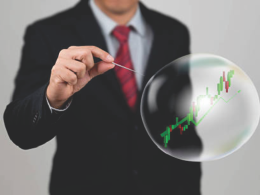by Alex Cousley, Russell Investments
On the latest edition of Market Week in Review, Investment Strategist Alex Cousley and Senior Client Investment Analyst Chris Kyle discussed third-quarter U.S. GDP (gross domestic product) numbers and third-quarter earnings from around the globe. They also chatted about recent central-bank headlines and provided an update on key risks to Chinese economic growth.
GDP growth rate slows to 2% in U.S.
U.S. third-quarter GDP grew at an annualized rate of 2%—the slowest quarterly pace of expansion in over a year, Cousley said, noting that consensus expectations had called for 2.7% growth. He attributed the weaker-than-expected number to two factors: a slowdown in consumer spending amid the surge of the delta variant of COVID-19 and ongoing supply-chain disruptions. “Persistent bottlenecks in the global supply chain really hampered U.S. auto sales last quarter, leading to a 1.4% drag on GDP,” Cousley explained, adding that he expects fourth-quarter GDP growth to be more robust.
On a more positive note, third-quarter earnings season in the U.S. continues to exceed expectations, he said, resulting in upward revisions to growth estimates. “At the start of earnings season, expectations were for an earnings growth rate of 30%. Today, that estimate sits around 38%, due in large part to the growth rates of value companies,” Cousley remarked.
Earnings season is also underway across Europe and Japan, he stated, although not as many companies have reported results yet. Cousley noted that so far, fewer companies in these regions are beating expectations when compared to the previous two quarters, but that overall, earnings growth is still decent.
Will the ECB raise rates in 2022? And what’s happening in the Australian bond market?
The week of Oct. 25 was marked by several central-bank policy meetings, Cousley noted, including that of the European Central Bank (ECB), the Bank of Canada (BoC) and the Central Bank of Brazil. The main takeaway from the ECB meeting was that officials don’t see a rate hike as a given in 2022, he said, despite rising inflation. “Markets are currently pricing in a rate increase for next year, but ECB President Christine Lagarde pushed back on this notion during the ensuing news conference, noting that while inflationary pressures have lasted longer than anticipated, officials still expect the sharp rise in prices to be temporary,” Cousley explained.
He added that the ECB’s next meeting, in mid-December, looms large for investors, as the central bank is likely to decide then what to do with its regular asset-purchase program (APP). The ECB currently has two asset-purchase programs in place, Cousley explained: the APP and the Pandemic Emergency Purchase Program (PEPP). “The PEPP is expected to end in March 2022, so the ECB will need to determine whether it should increase the APP in order to offset the ending of the PEPP,” he stated.
The BoC’s Oct. 27 meeting also caught the attention of markets, Cousley said, with the Canadian central bank announcing that its quantitative-easing program is ending. The BoC also signaled that it may begin increasing interest rates earlier than anticipated, he added. “At Russell Investments, we’re now anticipating a rate hike from the BoC in the third quarter of 2022,” Cousley said.
Meanwhile, the Central Bank of Brazil made headlines on Oct. 26 by raising its benchmark interest rate by 1.5%, he added. “This continues the theme of policy tightening among emerging-market central banks, which are more sensitive to inflation shocks and inflationary pressures,” Cousley explained, noting that the Central Bank of Brazil’s key rate now stands at 7.75%.
Shifting to Australia, he noted that the yield on the 3-year government bond maturing in April 2024 rose to over 50 basis points on Oct. 28—well above the Reserve Bank of Australia (RBA)’s target level of 10 basis points. This led to expectations that the bank would defend its bond-yield target by buying April 2024 government bonds, but as of Oct. 29, that had yet to happen, Cousley said. “Due to the RBA’s yield-curve control program, there’s been intense pressure for the central bank to step in,” he stated. The lack of action from the RBA has led investors to anticipate that rate hikes may be coming much sooner than expected, Cousley said, adding that he believes the market is probably getting ahead of itself. “I think that 2023 is the most likely timeframe for the RBA to start raising rates—which would likely be well after the first U.S. Federal Reserve rate hike,” he stated.
Could China’s beleaguered property sector dampen economic growth?
Cousley and Kyle wrapped up the segment with a look at the key risks facing China: another COVID-19 outbreak and the woes of its indebted property sector. The current outbreak is centered around two areas: the northwestern city of Lanzhou, home to 4 million residents, and the Inner Mongolia region, he said. While both areas are under fresh lockdowns, the real watchpoint for investors is whether either of these outbreaks could spread more broadly to Beijing and trigger new restrictions, Cousley remarked.
“China has a zero-tolerance approach to combating COVID-19, which is likely to remain in place through at least February, when the Winter Olympics are held in Beijing. This could make for an interesting situation if the outbreak worsens in Beijing, given its role as the economic hub of China,” he stated.
Meanwhile, the country’s embattled property sector is likely to be a drag on economic growth, Cousley said, noting that many analysts have lowered their expectations for GDP growth in 2022 to 5%. “That’s down from a 5.5% projection a few months ago, before the Evergrande saga unfolded,” Cousley observed.
Evergrande isn’t the only property developer at risk of default, he said, with a number of other companies in the sector also in financial trouble, including Kaisa Group. “While Kaisa is a much smaller developer than Evergrande, the company’s debt burdens are looking increasingly problematic,” he noted. That said, Cousley stressed that, in his opinion, China’s property-sector issues are likely to remain contained for now. “At this point, I don’t foresee this turning into a Lehman Brothers moment for China, but the situation bears close watching,” he concluded.
















